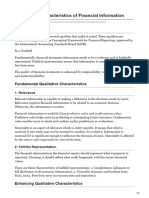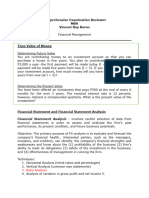Features of Money Market
Features of Money Market
Uploaded by
Anurita MajumdarCopyright:
Available Formats
Features of Money Market
Features of Money Market
Uploaded by
Anurita MajumdarCopyright
Available Formats
Share this document
Did you find this document useful?
Is this content inappropriate?
Copyright:
Available Formats
Features of Money Market
Features of Money Market
Uploaded by
Anurita MajumdarCopyright:
Available Formats
Features of Money Market The following are the general features of a money market: It is market purely for short-term
funds or financial assets called near money. It deals with financial assets having a maturity period up to one year only. It deals with only those assets which can be converted into cash readily without loss and with minimum transaction cost. Generally transactions take place through phone i.e., oral communication. Relevant documents and written communications can be exchanged subsequently. There is no formal place like stock exchange as in the case of a capital market. Transactions have to be conducted without the help of brokers. The components of a money market are the Central Bank, Commercial Banks, Non-banking financial companies, discount houses and acceptance house. Commercial banks generally play a dominant in this market. Objectives of Money Market The following are the important objectives of a money market: To provide a parking place to employ short-term surplus funds. To provide room for overcoming short-term deficits. To enable the Central Bank to influence and regulate liquidity in the economy through its intervention in this market. To provide a reasonable access to users of Short-term funds to meet their requirements quickly, adequately and at reasonable costs
Major participants and players in financial markets In the financial markets, there is a flow of funds from one group of parties (funds-surplus units) known as investors to another group (funds-deficit units) which require funds. However, often these groups do not have direct link. The link is provided by market intermediaries such as brokers, mutual funds, leasing and finance companies, etc. In all, there is a very large number of players and participants in the financial market. These can be grouped as follows : The individuals: These are net savers and purchase the securities issued by corporates. Individuals provide funds by subscribing to these security or by making other investments. The Firms or corporates: The corporates are net borrowers. They require funds for different projects from time to time. They offer different types of securities to suit the risk preferences of investors Sometimes, the corporates invest excess funds, as individuals do. The funds raised by issue of securities are invested in real assets like plant and machinery. The income generated by these real assets is distributed as interest or dividends to the investors who own the securities. Government: Government may borrow funds to take care of the budget deficit or as a measure of controlling the liquidity, etc. Government may require funds for long terms (which are raised by issue of Government loans) or for short-terms (for maintaining liquidity) in the money market. Government makes initial investments in public sector enterprises by subscribing to the shares, however, these investments (shares) may be sold to public through the process of disinvestments.
Regulators: Financial system is regulated by different government agencies. The relationships among other participants, the trading mechanism and the overall flow of funds are managed, supervised and controlled by these statutory agencies. In India, two basic agencies regulating the financial market are the Reserve Bank of India (RBI ) and Securities and Exchange Board of India (SEBI). Reserve Bank of India, being the Central Bank, has the primary responsibility of maintaining liquidity in the money market It undertakes the sale and purchase of T-Bills on behalf of the Government of India. SEBI has a primary responsibility of regulating and supervising the capital market. It has issued a number of Guidelines and Rules for the control and supervision of capital market and investors protection. Besides, there is an array of legislations and government departments also to regulate the operations in the financial system . Market Intermediaries: There are a number of market intermediaries known as financial intermediaries or merchant bankers, operating in financial system. These are also known as investment managers or investment bankers. The objective of these intermediaries is to smoothen the process of investment and to establish a link between the investors and the users of funds. Corporations and Governments do not market their securities directly to the investors. Instead, they hire the services of the market intermediaries to represent them to the investors. Investors, particularly small investors, find it difficult to make direct investment. A small investor desiring to invest may not find a willing and desirable borrower. He may not be able to diversify across borrowers to reduce risk. He may not be equipped to assess and monitor the credit risk of borrowers. Market intermediaries help investors to select investments by providing investment consultancy, market analysis and credit rating of investment instruments. In order to operate in secondary market, the investors have to transact through share brokers. Mutual funds and investment companies pool the funds(savings) of investors and invest the corpus in different investment alternatives. Some of the market intermediaries are: Lead Managers Bankers to the Issue Registrar and Share Transfer Agents Depositories Clearing Corporations Share brokers Credit Rating Agencies Underwriters Custodians Portfolio Managers Mutual Funds Investment Companies These market intermediaries provide different types of financial services to the investors. They provide expertise to the securities issuers. They are constantly operating in the financial market. Small investors in particular and other investors too, rely on them. It is in their (market intermediaries) own interest to behave rationally, maintain integrity and to protect and maintain reputation, otherwise the investors would not be trusting them next time. In principle, these intermediaries bring efficiency to corporate fund raising by developing expertise in pricing new issues and marketing them to the investors.
You might also like
- Odyssey Private Equity Compensation Report 2023 Candidate Version 1Document42 pagesOdyssey Private Equity Compensation Report 2023 Candidate Version 1RMC123No ratings yet
- Ascots Ascots Ascots Ascots: UnderstandingDocument24 pagesAscots Ascots Ascots Ascots: UnderstandingPratik GiteNo ratings yet
- Technical Analysis of Infosys TechnologyDocument70 pagesTechnical Analysis of Infosys Technologybipulraj_234567% (3)
- Unit 2 Financial System and Its ComponenetsDocument54 pagesUnit 2 Financial System and Its Componenetsaishwarya raikar100% (1)
- MFI Unit 01Document13 pagesMFI Unit 01Shreejan PandeyNo ratings yet
- Secondary MarketDocument13 pagesSecondary MarketKanchan GuptaNo ratings yet
- Management of Funds Entire SubjectDocument85 pagesManagement of Funds Entire SubjectMir Wajahat Ali100% (1)
- Gma Financial Ratio CompileDocument5 pagesGma Financial Ratio CompileVan Errl Nicolai SantosNo ratings yet
- Question: What Are The Functional Areas Of: Financial Management?Document3 pagesQuestion: What Are The Functional Areas Of: Financial Management?Madhubala SinghNo ratings yet
- Objectives of Preparing Financial StatementDocument13 pagesObjectives of Preparing Financial StatementJhesnil SabundoNo ratings yet
- Module 3 Lesson 3Document15 pagesModule 3 Lesson 3Marivic TolinNo ratings yet
- Financial Management - Chapter 9Document17 pagesFinancial Management - Chapter 9mechidreamNo ratings yet
- Focus StrategyDocument14 pagesFocus Strategysai praneethNo ratings yet
- Finma7 Module3Document11 pagesFinma7 Module3melody longakitNo ratings yet
- Management of Financial InstitutionsDocument165 pagesManagement of Financial Institutionskannnamreddyeswar80% (5)
- Chap 17Document34 pagesChap 17ridaNo ratings yet
- ZCG MPA Research4Document31 pagesZCG MPA Research4Hannah Bella JoungNo ratings yet
- Financial Market Part 1 PDFDocument23 pagesFinancial Market Part 1 PDFsanjayifmNo ratings yet
- Pas 1Document7 pagesPas 1BUQUIRAN, MARY JOYNo ratings yet
- Generally Accepted Accounting Principles (GAAP)Document7 pagesGenerally Accepted Accounting Principles (GAAP)Laxmi GurungNo ratings yet
- Overview of Financial ManagementDocument14 pagesOverview of Financial ManagementMarylou De MelloNo ratings yet
- Mini STRAMA Paper OutlineDocument11 pagesMini STRAMA Paper OutlineViancaNo ratings yet
- Factor Proportions Theory of International TradeDocument2 pagesFactor Proportions Theory of International TradehymonicaNo ratings yet
- Twenty-Three Investment CompaniesDocument17 pagesTwenty-Three Investment CompaniesMahendra SinghNo ratings yet
- Ifrs 12: Disclosures of Interest in Other EntitiesDocument3 pagesIfrs 12: Disclosures of Interest in Other EntitiesAira Nhaira MecateNo ratings yet
- Recognition and MeasurementDocument16 pagesRecognition and MeasurementajishNo ratings yet
- Financial System - Wikipedia PDFDocument15 pagesFinancial System - Wikipedia PDFSatya ReddyNo ratings yet
- Ifim Unit 1 - NotesDocument17 pagesIfim Unit 1 - NotesJyot DhamiNo ratings yet
- Course Outline For Philosophy of Business Aug Nov 2023 1Document2 pagesCourse Outline For Philosophy of Business Aug Nov 2023 1Renan Villaceran100% (1)
- AUDIT-An Overview: Auditing DefinedDocument16 pagesAUDIT-An Overview: Auditing DefinedAdan EveNo ratings yet
- Dfi 306 Public FinanceDocument134 pagesDfi 306 Public FinanceElizabeth MulukiNo ratings yet
- Economic Concepts Principles and Market Dynamics - With Track ChangesDocument109 pagesEconomic Concepts Principles and Market Dynamics - With Track ChangesMmapontsho TshabalalaNo ratings yet
- Chapter 11: The Capital MarketDocument5 pagesChapter 11: The Capital MarketMike RajasNo ratings yet
- Auditor Independence: Independence of Mind and AppearanceDocument3 pagesAuditor Independence: Independence of Mind and AppearancemanderiaNo ratings yet
- Fraud in The PhilippinesDocument2 pagesFraud in The PhilippinesJessa Caberte100% (1)
- Strategic Marketing For Micro Finance InstitutionsDocument33 pagesStrategic Marketing For Micro Finance InstitutionsKshitij JindalNo ratings yet
- Cash Management ArokianewmanDocument133 pagesCash Management ArokianewmaneswariNo ratings yet
- Qualitative Characteristics of Financial InformationDocument2 pagesQualitative Characteristics of Financial InformationHamza AlBulushiNo ratings yet
- Module Financial InstitutionDocument13 pagesModule Financial InstitutionZeeshan NazirNo ratings yet
- Effect of Misrepresentation of Information in A Financial StatementDocument82 pagesEffect of Misrepresentation of Information in A Financial Statementachiever usangaNo ratings yet
- The Impact of Internal Control System On PDFDocument52 pagesThe Impact of Internal Control System On PDFAbdikarim0% (1)
- Investments and Portfolio ManagementDocument5 pagesInvestments and Portfolio ManagementFedrick BuenaventuraNo ratings yet
- Chapter 2 ALMOST DONEDocument12 pagesChapter 2 ALMOST DONEayieeNo ratings yet
- Chapter 2-Audits of Financial Statements PDFDocument23 pagesChapter 2-Audits of Financial Statements PDFCaryll Joy BisnanNo ratings yet
- Financial Statements AnalysisDocument5 pagesFinancial Statements AnalysisShaheen MahmudNo ratings yet
- Accounting SoftwareDocument3 pagesAccounting SoftwareSwetaNo ratings yet
- What Is Funds Management?Document2 pagesWhat Is Funds Management?KidMonkey2299No ratings yet
- T1 Introduction (Answer)Document5 pagesT1 Introduction (Answer)Wen Kai YeamNo ratings yet
- Explain What Corruption IsDocument6 pagesExplain What Corruption IsMelody BTOB100% (1)
- Chapter 1: The Study of Accounting Information SystemsDocument36 pagesChapter 1: The Study of Accounting Information SystemsAliah CyrilNo ratings yet
- Financial Institution and MarketDocument52 pagesFinancial Institution and Marketsabit hussenNo ratings yet
- International FinanceDocument1 pageInternational FinanceShivarajkumar JayaprakashNo ratings yet
- Chapter 6 Comparable Companies AnalysisDocument46 pagesChapter 6 Comparable Companies AnalysisLAMOUCHI RIMNo ratings yet
- Strategic Capacity Management: Discussion QuestionsDocument11 pagesStrategic Capacity Management: Discussion QuestionsTTNo ratings yet
- M1 - Introduction To Valuation HandoutDocument6 pagesM1 - Introduction To Valuation HandoutPrince LeeNo ratings yet
- Aggregate Planning and SchedulingDocument19 pagesAggregate Planning and Schedulingchrisrobin99No ratings yet
- CH-6-Efficient Capital MarketsDocument9 pagesCH-6-Efficient Capital MarketsMoin khanNo ratings yet
- Capital StructureDocument9 pagesCapital StructureRavi TejaNo ratings yet
- Informal Organization - Wikipedia, The Free EncyclopediaDocument6 pagesInformal Organization - Wikipedia, The Free EncyclopediaapshapadaliyaNo ratings yet
- Value Chain Management Capability A Complete Guide - 2020 EditionFrom EverandValue Chain Management Capability A Complete Guide - 2020 EditionNo ratings yet
- Investment-Ravi Shukla PDFDocument210 pagesInvestment-Ravi Shukla PDFToriqul IslamNo ratings yet
- How Do Private Equity Investors Create Value - 2006 - Ernst and YoungDocument12 pagesHow Do Private Equity Investors Create Value - 2006 - Ernst and YoungAsiaBuyoutsNo ratings yet
- Doctrines of Cases in Securities Regulation CodeDocument1 pageDoctrines of Cases in Securities Regulation Codejolly verbatimNo ratings yet
- Reviewer Financial ManagementDocument7 pagesReviewer Financial Managementldeguzman210000000953No ratings yet
- AFA Model Question PaperDocument17 pagesAFA Model Question PaperWinner ANo ratings yet
- Hedging Strategies Using Futures PDFDocument11 pagesHedging Strategies Using Futures PDFRishabh GuptaNo ratings yet
- Principles of Marketing Comm-512Document2 pagesPrinciples of Marketing Comm-512zainwalliNo ratings yet
- ACCA P4 Mock Exam QuestionsDocument13 pagesACCA P4 Mock Exam QuestionsGeo DonNo ratings yet
- Capital Budegeting Case StudyDocument2 pagesCapital Budegeting Case StudyRohit PanpatilNo ratings yet
- 23 MergersDocument44 pages23 MergerssiaapaNo ratings yet
- Preparation of Separate Financial StatementsDocument29 pagesPreparation of Separate Financial StatementschingNo ratings yet
- Darya-Varia Laboratoria TBKDocument3 pagesDarya-Varia Laboratoria TBKArsyitaNo ratings yet
- Short Article On FPODocument2 pagesShort Article On FPOkhushi soniNo ratings yet
- Ratio Analysis: Ratio Analysis: A Ratio Analysis Is A Quantitative Analysis of Information ContainedDocument9 pagesRatio Analysis: Ratio Analysis: A Ratio Analysis Is A Quantitative Analysis of Information ContainedPatnana ArunaNo ratings yet
- Due List 20241115115658763Document3 pagesDue List 20241115115658763sapkotasarmila07No ratings yet
- Aggregate Sub-Base Course, (0.00-0.20M THK)Document1 pageAggregate Sub-Base Course, (0.00-0.20M THK)Civil EngineerNo ratings yet
- Value InvestingDocument19 pagesValue InvestingAshutosh GuptaNo ratings yet
- RWJ Corp 12e PPT Ch13Document34 pagesRWJ Corp 12e PPT Ch13eng.hfk06No ratings yet
- Assignment 1Document4 pagesAssignment 1Hiwot kassaNo ratings yet
- Amazon Financial Statement AnalysisDocument4 pagesAmazon Financial Statement Analysisapi-270738730No ratings yet
- Afar 07 15 NpoDocument6 pagesAfar 07 15 NpoLeo M. SalibioNo ratings yet
- Examining The Markets For Nordic Electricity Price Area Differentials (EPAD) Focus On FinlandDocument82 pagesExamining The Markets For Nordic Electricity Price Area Differentials (EPAD) Focus On FinlandmikaelcollanNo ratings yet
- Deep Value Investing Themes by Prof. Sanjay BakshiDocument23 pagesDeep Value Investing Themes by Prof. Sanjay Bakshiindianequityinvestor100% (1)
- Intermediate Accounting: IFRS Edition Donald E. Kieso 2024 Scribd DownloadDocument52 pagesIntermediate Accounting: IFRS Edition Donald E. Kieso 2024 Scribd Downloadlugnawirken100% (1)
- Tugas Warren Ex 20-16Document1 pageTugas Warren Ex 20-16Wezzulfrico AlfasaNo ratings yet
- Hull-White ModelDocument5 pagesHull-White Modeljackie555No ratings yet
- Recent Tools For Stock Price Forcasting: Anchor FacultyDocument25 pagesRecent Tools For Stock Price Forcasting: Anchor FacultyPankaj KumarNo ratings yet

























































































